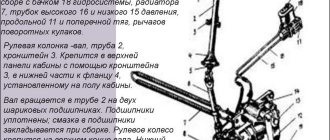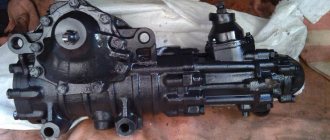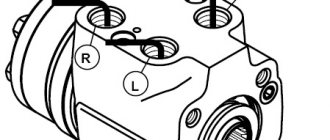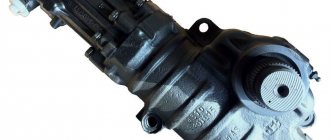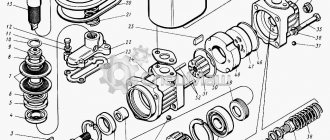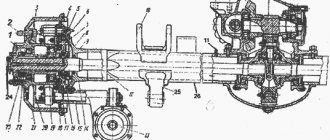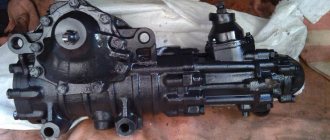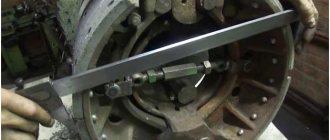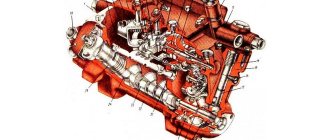Category: KAMAZ
- Feasibility of application
- Power steering components
- Power steering KamAZ 4310 device and adjustment
- Performance indicators
- Causes and symptoms of malfunctions
- Pumping the hydraulic booster KamAZ 4310
The weight of the truck reaches fifteen tons, it is difficult to imagine how the average person would drive such a “block” if not for the KamAZ 4310 power steering. For this reason, vehicles produced at the Kama plant are equipped with a similar mechanism.
Most users are accustomed to this fact and perceive power steering as a “proper” feature. However, do not forget that the mechanism requires care and attention, since the laws of physics also affect it. The key to trouble-free operation, the hydraulic component. Elimination of emergency situations associated with air entering the circuit is the main problem affecting the correct operation of the unit.
Compliance with the rules and requirements will make it easier to operate the truck, minimize the force applied to the steering wheel, reduce fatigue, and make it safer to drive on the road.
KamAZ-4310:
Feasibility of application
The main purpose of using power steering is to reduce the pressure created on the steering wheel of the car. Thanks to the effect, it is easier for the user to drive a car, and as a result, fatigue does not occur so quickly. It is also important that in the event of an emergency or force majeure situation, the driver will respond to changes more easily and quickly by adjusting the vehicle’s behavior and performing a maneuver.
In addition, power steering is involved in passive safety. Thus, an increase in speed is accompanied by an increase in resistance on the control wheel. This makes it possible to maintain a given trajectory without deviating from the course (which is fraught with an emergency). Breakage of the product does not lead to a complete loss of control; this once again indicates the safety of the unit. Premature worries are not appropriate, since failure is rare, but the joint operation of the amplifier and the car will bring a lot of positive aspects.
Amplifier KamAZ (Article 4310-3400020-03):
We repair and adjust the power steering on a KAMAZ with our own hands
The hydraulic steering control system is an integral part of any KAMAZ, since without it, steering the vehicle will be, if not impossible, then very difficult. Thanks to this unit, the driver can turn the steering wheel with greater ease. You can learn more about what the KAMAZ power steering system is and how to de-air it from this material.
Power steering components
The design of the power steering includes parts and assemblies combined into one mechanism with a common closed loop.
Main components of the amplifier:
- Distribution device.
The purpose of the unit is to direct hydraulic oil, used as a working fluid, into the pipes and voids of the circuit.
- Hydraulic cylinder.
The unit is designed to convert fluid pressure into mechanical work. This is done by means of a displacer and rods attached to them.
- Hydraulic oil.
The material is used as a working fluid. This happens due to the properties of the liquid, such as fluidity and non-compressibility. The oil transmits the pump force to the hydraulic cylinder. In addition, it is used as a preservative and also lubricates rubbing parts, reducing friction.
How to remove an air lock from the system?
The need to bleed the system usually arises after refueling it or eliminating breakdowns in the operation of the unit. Air entering the lines leads to less efficient operation of the hydraulic booster, so the only solution in this case is to remove the air.
So, how to bleed the power steering:
- First you need to move the front axle so that the car's wheels do not touch the ground. Using a jack, you should place supports under the beam on both sides. If the wheels are on the ground, bleeding of the system cannot be started.
- Then you need to remove the filler cap of the expansion tank located under the hood.
- Next, the rubberized cap should be removed from the bypass valve, and an elastic pipe should be installed on its head. In this case, its open part should be lowered into a glass container, the volume of which will be at least half a liter. The vessel itself should be filled halfway with the working fluid.
- Then the bypass valve should be opened slightly, half a turn.
- After completing these steps, turn the steering wheel to the left all the way. After this, the working fluid is poured into the expansion tank until its level decreases.
- Then you need to start the power unit, and while it is operating at minimum speed, pour a little liquid into the expansion tank, but without allowing the level to drop. Do this until bubbles stop coming out of the pipe that is installed on the bypass valve. After this, the valve itself can be closed.
- Next, the steering wheel should be turned all the way to the right, and then to the left. And holding the steering wheel in this position, again unscrew the bypass valve halfway and observe whether bubbles come out of the pipe. When they stop coming out, the valve can be tightened.
- This operation must be carried out several times, ultimately a clear liquid will come out of the valve, in which any impurities or air bubbles should be absent. If bubbles continue to come out, the procedure should be repeated several more times, but do not forget to monitor the volume of working material in the expansion tank.
- Then all you have to do is turn off the motor and remove the pipe from the valve head. Put the cap on the head itself, and then again diagnose the volume of liquid in the tank. If there is a need, it will need to be added. Further assembly of all components is carried out in reverse order.
Power steering KamAZ 4310 device and adjustment
To understand how the amplifier functions, let's look at a schematic representation of the mechanism's operation. The figure shows that the movement of the KamAZ - 4310 vehicle in a straight position forces the auger (15) and the device that reorients the flow (20) to adhere to the middle. This position forms a single connection of elements: supply and discharge channels (26, 32, respectively), voids (7) and (25) of the hydraulic chamber. At the same time, the lubricant circulates freely, making its way from the pump through the control valve (19) and again enters the reservoir of the hydraulic circuit (31).
Turning the steering wheel (1), see diagram, provokes rotation of the screw (15). Removing the wheels (12) from the equilibrium position causes resistance from the rack piston (8), which controlled the linear movement. The resulting force tends to move the auger along the axis in the direction of rotation; this is prevented by the centering spring elements (23). The force exceeding the spring force moves the auger, moving the flow reorientation device behind it. The consequence of the actions taken is that the chamber void communicating with the discharge channel is disconnected from the drain channel and vice versa. The liquid pumped into the void of the channel by the pump acts on the rack valve (8), forming a pressure on the sectoral mechanism (6) of the bipod. It becomes easier to turn the wheels.
Amplifier bipod KamAZ-4310:
The pressure in the voids of the power steering KamAZ 4310 3400020 03 is stabilized, leveling out to the level of resistance to wheel rotation. At the same time, the compression of the cavity of the reactive displacers (22) increases. The resistance increases in tandem with the pressure in the working chamber; accordingly, the force of the spool valve to return to the middle position increases, transmitting information to the steering wheel. Interaction helps the user to better understand and feel the road.
How to change oil in power steering Kamaz
To change the power steering oil, you need to bleed it; this action will remove air from the system. Air should not be left in the system.
- First, you need to open the valve on the steering mechanism, it is also called the bypass valve;
- Then compress the centering springs. This can be done by turning the steering wheel to the left all the way;
- Fill the pump with oil;
- The power device must be turned on, and at this time you add oil slowly and gradually, and see if air bubbles come out of the hose. If the bubbles stop coming, that means enough;
- Screw back the bypass valve;
- Again, compress the centering springs, only now you need to turn the steering wheel to the right as far as possible, and the springs should compress, and immediately return it back to the left all the way, again twist the bypass valve to see if any air bubbles are released. After all the air has come out, the valve can be screwed back on;
- Do the action from the previous point until all the air comes out and only oil comes out of the valve.
How to remove an air lock from the power steering system
- Suspend the front axle so that the wheels do not touch the ground. The truck is lifted with a jack and trestles are placed under the beam on both sides;
- Remove the caps from the neck of the tank through which the oil is poured;
- Remove the rubber pads from the bypass valve and fix them on the spherical head of the elastic hose. Place the other end in a glass vessel with a volume of 0.5 liters, half filled with oil;
- Unscrew the bypass valve half to three-quarters of a turn;
- Turn the steering wheel to the left all the way;
- Fill the pump tank with lubricant to a level where it will not drop;
- Start the engine and add oil while rotating the crankshaft at low speed. It is necessary that the oil level does not decrease until the formation of air bubbles stops at the outlet of the hose located on the bypass valve;
- Next, you need to close the bypass valve;
- Turn the steering wheel to the right all the way and back, to the left all the way. Hold the steering wheel in this position and turn the bypass valve half to three-quarters of a turn. Here you also need to control the release of air bubbles. After the air has escaped, the bypass valve closes;
- Repeat step 9 several times. It is important to ensure that clean oil (without air impurities) ultimately comes out of the valve;
- Stop the motor;
- Remove the hose and attach the protective cap to the valve head. Then check the lubricant level in the pump reservoir. If the tie rod was disconnected, you need to reinstall it.
Adjusting power steering KAMAZ
The steering mechanism can only be checked and adjusted in the position when the engine is turned off and the longitudinal steering rod is disconnected.
Before starting work, you need to check the wheel balancing, pressure level, presence of oil in the steering and hubs, settings of wheel bearings and rods, functioning of shock absorbers, quality of installation of the front wheels, oil level in the pump.
To check the force of the steering column, a dynamometer mounted on the wheel rim is used. The force is checked at different positions of the steering wheel: when turning 2 or more turns from the initial position, when turning three-quarters of a turn, when the wheel passes the initial position.
Forces that do not correspond to the specified values in the required positions must be adjusted. This may require dismantling the unit, its partial or complete disassembly:
- First, the adjustment is made in the third position, the adjustment is carried out using the bipod shaft screw;
- Then the first position is adjusted - you need to tighten or loosen the mounting location of the thrust bearings (partial disassembly of the mechanism is required);
- Adjustment in the second position is carried out with complete disassembly of the hydraulic booster.
Performance indicators
Structurally, the mechanism that controls the movement of vehicles includes: a device that changes the movement of the shaft at an angle, a device that distributes the force of an axial type fluid, and an integrated force chamber. Regarding the transmission mechanism used, the following are used: “auger-ball”, “nut-displacer”, toothed quarter circle with a conical rack.
Amplifier parameters (3400020):
| Index | Explanation |
| Force on the front pair of wheels, (t) | 5,5 |
| Torsion impulse of the amplifier output shaft, pressure 9MPa, (Nm) | 4000 |
| Possible heating of the amplifier lubricant, (°C) | 90 |
| Ratio of driven and driven amplifier teeth | 21.7 to 1 |
| Bipod shaft seal GUR KamAZ 4310 size, (mm) | 57,2*76*8 |
| Booster pressure limiting valve (MPa) | 8-9 |
| Passability of the amplifier distribution device, (dm3/min) | 15 |
| Amplifier bipod eversion, (deg.) | 86 |
| Amplifier groove, directivity | left |
| Amplifier weight, (kg) | 47,2 |
KamAZ amplifier bipod oil seal:
Characteristics of power steering
- Steering mechanism - has a hydraulic booster installed in the same housing as the steering mechanism. The device includes a screw with a nut on rotating shafts and a piston that comes into contact with the toothed part of the bipod shaft.
- Gear ratio – 20
- The control valve is a spool valve, made with safety and bypass valves.
- The pump is a rotary mechanism with blades and a gear drive, gear ratio 1.25.
- The steering and hydraulic power steering are driven by a cardan shaft connected by a sliding spline; the angular gear is equipped with bevel gears.
- The radiator is an aluminum structure with fins installed in front of the radiator of the cooling system.
- Steering drive - has two rods (transverse and longitudinal types) with ball joints without the possibility of adjustment.
You can see the general diagram of KamAZ power steering in the picture at the beginning of the section.
Causes and symptoms of malfunctions
The hydraulic booster is reliable and breaks down extremely rarely. Often breakdowns are associated with violation of operating conditions, or due to use of the car in the cold. The latter is accompanied by the fact that the bipod oil seal of the power steering KamAZ 4310 is leaking. The reason for the failure of the oil seals is an increase in oil thickness, as a result, an increase in pressure in the circuit. The positive point is that if the amplifier breaks unexpectedly, this will not affect safety; the driver will feel an increase in the force on the steering wheel.
In addition, it is necessary to prevent clogging of the mechanism, since dust and dirt often get inside the unit. This phenomenon leads to malfunction; this occurs due to increased wear and friction inside the amplifier, since dust and dirt act as an abrasive.
Common power steering faults
It must be said right away that repairing KAMAZ power steering is a procedure that our compatriots do not encounter so often. If the driver follows the basic rules for operating the unit, and also carries out its maintenance in a timely manner, then the likelihood that it will fail will be minimized. As practice shows, problems with the performance of the hydraulic booster mainly arise in the cold season. In general, all malfunctions can be divided into mechanical and hydraulic failures, both of which can occur in any part of the device.
As you know, any hydraulic system most often exhibits malfunctions in frosty conditions, in particular, temperature changes. After all, you need to remember that the pumping device pumps high pressure, so if the viscosity of the liquid in the system increases, this will lead to the squeezing out of the seals and, accordingly, its leakage. The problem of oil seals is especially evident in cars whose drivers do not follow operating rules, for example, leaving the car in a parking lot with the wheels twisted. This will lead to the fact that after starting the engine, the pressure will increase only on one side, accordingly, the oil seal will squeeze out in any case.
As for the warm season, in summer malfunctions usually appear as a result of dirt and dust getting into the system. If any part is depressurized, the wear of the bushings, as well as the rods, will be faster. Rods usually rust quite quickly, resulting in accelerated wear of the bushings. When operating a car with such a problem, after several hundred kilometers, there will be a large gap between these elements, and this, in turn, will lead to the steering rack starting to make a knock (author of a video about repairing the system in a garage - channel EIGHT ATMOSPHERE).
Disassembling and checking the power steering pump
To disassemble and check the power steering pump :
- remove the tank cap and unscrew the filter from the manifold;
- unscrew the fastening bolts and remove the tank with the manifold, remove the tube;
- Check the flatness of the manifold bearing surface on the control plate. The non-flatness of the specified surface is allowed no more than 0.1 mm with a roughness of 6.3 nm. If greater non-flatness is detected, mill the supporting surface of the collector, then check it on the plate, and replace the paronite gasket;
- install the power steering pump so that its shaft is positioned vertically, with the gear facing down, remove the four coupling bolts and, holding the bypass valve from falling out, remove the pump cover;
- Check the condition of the sealing surface of the seat for connecting the high pressure pipeline.
If the specified surface is significantly dented, which can cause a leak, use the MB bolt to remove the seat, having previously cut a thread in it. To prevent chips from getting into the valve, place grease in the seat hole. When pressing a new seat, use a mandrel;
- check the ease and smooth movement of the bypass valve in the cover hole under the influence of its own weight. When checking, the valve spring must be removed. If necessary, wash the valve and the hole in the lid with acetone, cleaning their working surfaces from adhering foreign particles or burrs.
The valve and cover are individually selected at the factory, so do not disassemble this pair (the gap in it on the new pump is 0.013... 0.023 mm).
If unacceptable wear is detected in this pair ( the power steering pump does not provide the required flow), replace the valve and cover as a whole;
- Check the pressure setting of the pump safety valve and the tightness of its seat.
Check the valve in a special device that allows you to supply oil under pressure to the hole in its seat, for example, a load-measuring stand MT-60 (Poland).
At oil pressure up to 7355 kPa (75 kgf/cm2), leakage from under the safety valve is unacceptable. If there are leaks, check the condition of the valve parts. To do this, unscrew the valve seat, keeping the existing adjusting shims, rinse the cavity in which the spring and ball are located, and check the cleanliness of the hole in the seat.
Check the integrity of the spring and reassemble the valve by tightening its seat to a torque of 14.7...19.6 Nm (1.5...2 kgfm).
The valve should open at a pressure of 8336... 8826 kPa (85... 90 kgf/cm2) and allow a continuous stream of oil to pass through. If the valve operates at a lower pressure, then the cause of the defect may be the settling of its spring due to a previous overheating of the pump. In this case, in order to eliminate the indicated defect, it is allowed to remove the adjusting shims from under the safety valve seat.
It should be borne in mind that removing one gasket with a thickness of 0.5 or 0.7 mm gives an increase in pressure, respectively, by approximately 686.5 or 980.7 kPa (7 or 10 kgf/cm2). It is not recommended to remove the last gasket from under the seat, since the absence of a gasket can lead to spontaneous loosening of the seats during vehicle operation.
In the absence of the special device mentioned above, the correct regulation of the safety valve can be checked on a stand assembled with a pump, including an electric motor with a power of at least 2.5 kW, driving the power steering pump through a gear drive. Pump shaft rotation speed 600 min1.
A pressure gauge with a measurement limit of 9807 kPa (100 kgf/cm2) and a valve must be installed in the pump pressure line. The length of the pipeline from the valve to the tank is at least 1 m. Before checking the pump, you should run it in for 10... 15 minutes, gradually increasing the pressure with the valve to 4904... 5349 kPa (50... 55 kgf/cm2);
- Insert the valve with the spring into the hole in the cover and once again make sure that its movements are smooth.
During all further operations of disassembling and subsequent assembly of parts of the pump pump unit, it should be kept in mind that the stator, rotor and pump blades are selected as a complete set at the manufacturer; When disassembling, do not disturb their completeness, do not swap the blades. When replacing the stator, rotor and blades, install them as a set;
- mark the relative positions of the distribution disk relative to the stator, and the latter relative to the pump housing and remove them from the pins. The arrow on the stator indicates the direction of rotation of the pump shaft;
- remove the rotor along with the blades, making sure that the blades do not fall out of their grooves;
- check the ease and smooth movement of the blades in the rotor grooves. If you find dirt or other foreign particles on the surfaces of mating pairs, remove the blades from the grooves and wash the parts with gasoline;
- to replace bearings or cuffs, if necessary, install the pump housing in a vice so that its shaft is positioned vertically, with the gear facing up, unscrew and unscrew the nut, holding the gear from turning; remove the gear together with the washer and remove the key from the shaft groove, as well as the ball bearing retaining ring. Using a puller, remove the shaft along with the bearing and oil ring from the pump housing.
Replace worn parts and reinstall the shaft; Check the smooth rotation of the shaft, then install the retaining ring.
Power steering pump repair
I'll tell you how I repaired the power steering pump. But first, a little background.
The steering wheel works without any complaints in a cold car in summer and winter. But as soon as the car warms up, especially in the summer, the steering wheel at idle becomes very tight, as if there is no power steering. In winter, this problem does not manifest itself as much, but it is still present. If you apply gas, the steering wheel immediately turns easier (though not quite ideally, but still easier). At the same time, the pump does not knock, does not ring, does not leak, etc... (the snotty rack is not taken into account) the oil is fresh and ideal (especially since, thanks to the condition of the rack, it is updated regularly!), the cardan is lubricated and does not stick!
In general, this is a clear sign of lack of performance of the power steering pump when the oil is hot at idle. I didn’t suffer for long, but in the end I decided to deal with this problem, spent a lot of time, scoured the Internet, understood the principle of the pump’s operation, found a similar description and decided to rebuild my “old” pump.
Serious fault
Now you know why oil foams in the power steering, and that its appearance can be very dangerous. If you were unable to fix the problem yourself, it is better to contact a service center. This will be much cheaper than replacing all system components of the circuit. At the same time, it is better to deliver the car to the service station using a tow truck, because we are talking about the integrity of your car, your health and even life.
Power steering is one of the main systems of the mechanism that sets the direction of movement. Its purpose is to facilitate vehicle control and ensure a stable position on the road.
Pumping the KamAZ hydraulic booster
If the mechanism has been repaired or filled with fluid, the next mandatory action is to pump the KamAZ power steering. The procedure is performed to eliminate air bubbles trapped inside the amplifier. If the air is not eliminated, the useful effect of the hydraulic control will drop sharply.
Power steering diagram of a KamAZ car:
Actions taken:
Raise a car with a KamAZ-740 engine, or another model, so that the wheels of the car hang in the air. For this purpose, support the beams on supports.
- Dismantle the filler plug of the expansion tank neck; Remove the rubber pad from the exhaust valve. Install the rubber tube in the vacant space, dip the free edge of the product into a container with lubricant in an amount of about 1/2 liter;
- Unscrew the transfer valve one-half turn;
- Turn the steering wheel all the way to the left, pour lubricant into the expansion tank;
- Start the power plant and let it idle. At this time, with the engine running, pour lubricant into the conservator reservoir, without allowing the level to drop. Make sure that no air bubbles come out of the valve tube - close the valve;
Air control:
- Alternately turn the steering wheel to the right and left. Make sure that the steering wheel remains stationary, unscrew the bypass valve 1/2 turn. Check to see if any air bubbles come out. When air does not flow, tighten the valve;
- Repeat the procedure, bleeding the power steering in a similar way as many times as required. A sign of the end of the process is the release of clean liquid from the free end of the hose without air impurities. If bubbles continue to come out, regulation is continued until the bubbles disappear completely;
- Turn off the power plant, remove the pipe, install the cap, diagnose the level of working fluid in the expansion tank, and add oil.
